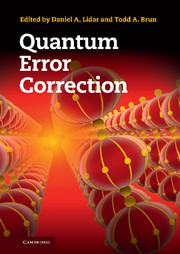Book contents
- Frontmatter
- Contents
- List of contributors
- Prologue
- Preface and guide to the reader
- Acknowledgements
- Part I Background
- Part II Generalized approaches to quantum error correction
- Part III Advanced quantum codes
- Part IV Advanced dynamical decoupling
- Part V Alternative quantum computation approaches
- Part VI Topological methods
- Part VII Applications and implementations
- 21 Experimental quantum error correction
- 22 Experimental dynamical decoupling
- 23 Architectures
- 24 Error correction in quantum communication
- Part VIII Critical evaluation of fault tolerance
- References
- Index
21 - Experimental quantum error correction
from Part VII - Applications and implementations
Published online by Cambridge University Press: 05 September 2013
- Frontmatter
- Contents
- List of contributors
- Prologue
- Preface and guide to the reader
- Acknowledgements
- Part I Background
- Part II Generalized approaches to quantum error correction
- Part III Advanced quantum codes
- Part IV Advanced dynamical decoupling
- Part V Alternative quantum computation approaches
- Part VI Topological methods
- Part VII Applications and implementations
- 21 Experimental quantum error correction
- 22 Experimental dynamical decoupling
- 23 Architectures
- 24 Error correction in quantum communication
- Part VIII Critical evaluation of fault tolerance
- References
- Index
Summary
Quantum error correction (QEC) is all for naught if it cannot be implemented experimentally in the laboratory. Further, even if it can be implemented in small laboratory experiments, these experiments need not lead to a technology that is scalable to large quantum computers (where large is defined as “big enough to contemporaneously outperform the best classical computer on some problem”). In this chapter we will survey some of the experiments that have been performed to implement QEC. These experiments are all a long way from demonstrating viable QEC, but demonstrate the proof-of-principle methods that will need to be implemented in the future if quantum computation is to be made viable. This chapter deals with experimental implementations whose goal is to implement QEC, and not experiments using passive or open-loop methods, which are covered in Chapter 22.
Experiments in liquid-state NMR
The first experiments that attempted to perform QEC were performed using room-temperature liquid-state NMR. Liquid-state NMR [CFH97, GC97] is a testbed for quantum computing ideas in which one uses the internal states of coupled nuclear spins from a molecule as the qubits in a quantum computer. In its original and experimentally implemented form, liquid-state NMR is not generally thought to be scalable: the signal used to read out the result of the quantum computation decays exponentially [W97] in the number of qubits in the system and the mixed states produced in these experiments can be shown to possess no quantum entanglement.
- Type
- Chapter
- Information
- Quantum Error Correction , pp. 509 - 518Publisher: Cambridge University PressPrint publication year: 2013
- 2
- Cited by

